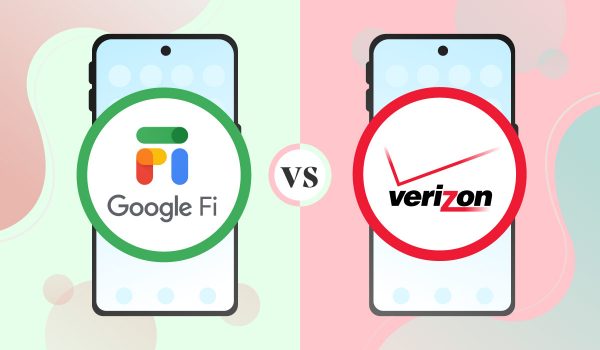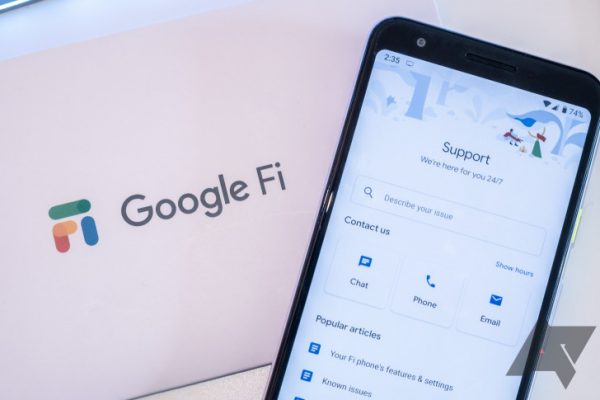Formerly called Project Fi on its initial release, Google Fi has become one of the most flexible mobile virtual network operators (MVNOs) available today. As an MVNO, Google Fi utilizes either one of the major mobile carriers in the U.S. – AT&T, Sprint, T-Mobile, and Verizon. That said, customers have more flexible choices in terms of mobile networks or data plans.
In terms of infrastructure, MVNOs don’t have their very own cell towers as well as maintaining and building them. As a result, MVNOs generally have more affordable plans compared to AT&T, Sprint, T-Mobile, and Verizon.
Is there anything Google can’t do? The tech giant is now dominant when it comes to web browsers, productivity suite, and email service, and now Google has become a mobile phone manufacturer and mobile phone plan provider.
However, in this article, we will discuss in-depth the significant comparisons of Google Fi vs Verizon based on internet coverage, customer service, prices, and mobile phone plans. To provide you with a comprehensive introduction, we also have a separate write-up on how Google Fi works.
Google Fi vs Verizon

Verizon is one of the well-known mobile carriers in the United States. In fact, more than 27% of Americans have Verizon for personal use, resulting in more than 61 million mobile phone users in the first quarter of 2018. However, it’s a little more expensive compared to other major carriers in the country. Without a doubt, Verizon’s coverage, speed, and performance are the best across the U.S.
You’re definitely getting what you pay for. Verizon coverage is robust and reliable enough compared to other mobile carriers in the country; hence, it’s one of the primary reasons why the majority of Americans use the network.
Network performance and coverage entirely depends on location, and this is Verizon’s greatest asset. Verizon coverage is better and more extensive. As such, even the most remote locations are covered by Verizon. If you prefer a more reliable and extensive data network, then Verizon is your best option.
Google Fi vs Verizon: Coverage and Performance
Now that Google Fi has joined the competition, it brings a unique advantage that can definitely match up with Verizon. Simplicity and flexibility are Google Fi’s best assets. Google Fi utilizes three major mobile carriers, namely, Sprint, T-Mobile, and U.S. Cellular. As a result, you are 100% guaranteed that you’re getting the most out of the three major carriers regardless of your location around the U.S.
Google Fi’s noteworthy advantage is that you don’t need to choose one network for the entire plan. If you have a smartphone bought directly from Google, or a Google Fi-compatible smartphone, your mobile phone can intelligently switch between the three networks to find the best network signal and strength possible.
If you are in a location where T-Mobile is faster than Sprint, your mobile network will switch to T-Mobile’s infrastructure, without your input. Your smartphone does all the work on the background, which makes it more convenient for you. If you want to know which mobile phones are compatible with Google Fi, you can visit Google Fi’s compatibility checker.
Having a smartphone that is integrated with three of the major networks in the country is pretty useful. Notably, T-Mobile’s network has wider coverage compared to U.S. Cellular and Sprint. Also, Google Fi users who own a 5G-compatible smartphone can enjoy the perks of having T-Mobile’s 5G network for free.
Lastly, Google Fi has access to Google’s almost two million free public Wi-Fi hotspots that are protected by the company’s very own VPN.
Google Fi vs Verizon: Pricing and Plans
These plans are the simplest and straightforward mobile data plans that ever existed. Google Fi only has two choices for mobile data plans – the Flexible plan, and the Unlimited Plan. In terms of pricing and plans, we will highlight a more clear and comprehensive comparison of Google Fi vs Verizon in this section.
Google Fi: Flexible Plan
If you don’t consume much data for your browsing needs or you prefer paying for only the amount of data you use, then Google Fi’s Flexible plan is your ideal option. As of this writing, here is the pricing for Google Fi’s Flexible Plan:
| Number of Users | Plan Cost | Data Cost | Total Cost |
|---|---|---|---|
| 1 | $20 | $10/GB | $20/month + Consumed Data Cost for the Month |
| 2 | $18 | $10/GB | $35/month + Consumed Data Cost for the Month |
| 3 | $17 | $10/GB | $50/month + Consumed Data Cost for the Month |
| 4 | $17 | $10/GB | $65/month + Consumed Data Cost for the Month |
| 5 | $16 | $10/GB | $80/month + Consumed Data Cost for the Month |
| 6 | $16 | $10/GB | $95/month + Consumed Data Cost for the Month |
For an introductory $20 price, Google Fi’s Flexible plan is bundled with numerous perks. It already includes unlimited texts and calls. In terms of unused mobile data, it’ll be credited back to the customer’s account. You will absolutely pay only for the mobile data you’ve consumed at the end of each month. In terms of sharing your mobile data, you’ll enjoy full-speed hotspot tethering for no additional charges. That said, you’ll only be billed for the data you’re allotted monthly.
Google Fi: Unlimited Plan
Similar to other mobile carriers in the U.S., Google Fi has its very own unlimited plan for customers who consume a hefty amount of mobile data each month. As of this writing, here is the pricing for Google Fi’s Unlimited Plan:
| Number of Users | Individual Cost | Total Monthly Cost |
|---|---|---|
| 1 | $70 | $70 |
| 2 | $60 | $120 |
| 3 | $50 | $150 |
| 4 | $45 | $180 |
| 5 | $45 | $225 |
| 6 | $45 | $270 |
With the Unlimited Plan from Google Fi, users can enjoy unlimited high-speed data of a maximum of 22 GB per person. If you already consume your monthly data allotment, you will experience slower speeds. Also, each member will enjoy Google One membership plan that includes 100 GB of cloud storage across Google Photos, Gmail, and Google Drive. No extra fees and hidden charges with your Google One subscription.
Verizon: Shared Data Plan – 5 GB
Verizon’s 5 GB Shared Data Plan can be split between two people per month, resulting in them only paying $25 each plus splitting the $30 monthly access fee. It is suitable for minimal data usage such as sending emails, streaming music for minimal usage, and minimal posting on social media accounts.
| Number of Users | Monthly Access Fee | Line Fee | Total Monthly Cost |
|---|---|---|---|
| 1 | $30 | $25 | $55 |
| 2 | $30 | $50 | $80 |
| 3 | $30 | $75 | $105 |
| 4 | $30 | $100 | $130 |
| 5 | $30 | $125 | $155 |
| 6 | $30 | $150 | $180 |
| 7 | $30 | $175 | $205 |
| 8 | $30 | $200 | $230 |
| 9 | $30 | $225 | $255 |
| 10 | $30 | $250 | $280 |
Verizon: Shared Data Plan – 10 GB
If you are a big fan of movie streaming platforms like Netflix or consume a hefty amount of mobile data, then perhaps choosing Verizon’s 10 GB Shared Data Plan is an excellent option for you. Similar to the 5 GB shared plan, you will only pay $25 per line every month plus $40 for the monthly access fee.
| Number of Users | Monthly Access Fee | Line Fee | Total Monthly Cost |
|---|---|---|---|
| 1 | $40 | $25 | $65 |
| 2 | $40 | $50 | $90 |
| 3 | $40 | $75 | $115 |
| 4 | $40 | $100 | $140 |
| 5 | $40 | $125 | $165 |
| 6 | $40 | $150 | $190 |
| 7 | $40 | $175 | $215 |
| 8 | $40 | $200 | $245 |
| 9 | $40 | $225 | $265 |
| 10 | $40 | $250 | $290 |
Verizon: Unlimited Plans
Verizon has its own unlimited plans that come with numerous perks. You can also mix and match your mobile phone plans on your account. Verizon’s Unlimited Plans include the following:
| Number of Plans You Can Mix and Match | Get More Unlimited
(Monthly Cost Per Line) |
Do More Unlimited
(Monthly Cost Per Line) |
Play More Unlimited
(Monthly Cost Per Line) |
Play More Unlimited
(Monthly Cost Per Line) |
|---|---|---|---|---|
| 1 | $100 | $90 | $90 | $80 |
| 2 | $90 | $80 | $80 | $70 |
| 3 | $75 | $65 | $65 | $55 |
| 4 | $65 | $55 | $55 | $45 |
| 5 to 10 | $60 | $50 | $50 | $40 |
Verizon: Discounted Unlimited Plans
| Number of Plans You Can Mix and Match | Get More Unlimited
(Monthly Cost Per Line) |
Do More Unlimited
(Monthly Cost Per Line) |
Play More Unlimited
(Monthly Cost Per Line) |
Start Unlimited
(Monthly Cost Per Line) |
|---|---|---|---|---|
| 1 | $90 | $80 | $80 | $70 |
| 2 | $80 | $70 | $70 | $60 |
| 3 | $65 | $55 | $55 | $45 |
| 4 | $55 | $45 | $45 | $35 |
| 5 to 10 | $50 | $40 | $40 | $30 |
Verizon’s $10 discount is only applicable to paper-free billing and payments made through debit cards, Verizon Visa Card, home banking, and checks only.
Google Fi vs Verizon: International Plans

Google Fi International Rates
When it comes to international phone plans, the majority commends Google Fi as the best plan for frequent travelers due to its affordability. You can make calls internationally at minimal to zero additional charges. With Google Fi’s Flexible and Unlimited Plans, you are automatically covered internationally – zero charges for texting, which makes it a great convenience for messaging loved ones from abroad.
| Unlimited Plan | Flexible Plan | |
|---|---|---|
| Data | Unlimited | $10/GB |
| Calls | $0.20/minute | $0.20/minute |
| Text | Unlimited | Unlimited |
With the Unlimited Plan, you can call abroad from the U.S. for free. The free calls are only applicable if you’re calling someone from 50+ destinations. For the Flexible plan, you can make calls for a very affordable price to select destinations.
Verizon International Rates
Verizon’s international plans are offered in three distinct pricing plans namely TravelPass, Monthly International Travel Plan, and Pay as You Go. All subscriptions and their corresponding fees are provided on Verizon’s website for international rates.
TravelPass
Verizon’s TravelPass provides you with wireless travel plans regardless of what country you will be traveling to. If you want to have unlimited calling and texting as well as 4G LTE connection as what you have at home while traveling, then TravelPass is definitely the best international coverage plan for you. There are no additional charges and hidden fees when you are subscribed to TravelPass. As such, you will only be billed on the days you use mobile data, send texts, or call someone on your smartphone while overseas.
| Mexico & Canada | 185+ Countries | |
|---|---|---|
| Data, Text, and Call | Domestic Plan Allotment | Domestic Plan Allotment |
| Daily Charge Per Device | $5 | $10 |
| Additional Perks | $0 for Unlimited Plans | N/A |
Monthly International Travel Plan
If you have occasional travels but not as frequent as a nomad, you can add a one-time monthly subscription of mobile data, texts, and calls. For longer/multiple travels, you can also have a monthly international subscription on your existing Verizon account and remove it when you no longer need it. The rates apply to more than 185 countries around the world.
| 185+ Countries | ||
| Monthly Fee | $70 | $130 |
| Call | 100 minutes | 250 minutes |
| Text | Sent: 100
Received: Unlimited |
Sent: 1,000
Received: Unlimited |
| Mobile Data | 0.5 GB | 2 GB |
Pay as You Go
If you don’t fancy paying a monthly fee from Monthly International Travel Plan, and TravelPass, you can choose the Pay as You Go option.
| Canada, Guam, Mexico, and the Northern Mariana Islands | 130+ Countries | 80+ Countries | |
|---|---|---|---|
| Call | $0.99 per minute | $1.79 per minute | $2.99 per minute |
| Text | Sent: $0.50
Received: $0.05 |
||
| Multimedia Messaging | Sent: $0.25
Received: $0.25 |
||
| Mobile Data | $2.05/MB | ||
Google Fi vs Verizon: Customer Service

Speaking of customer service quality, both Google Fi and Verizon have satisfactory performance. Verizon’s website has a comprehensive one-stop-shop for all inquiries related to mobile data and pricing plans. The website also connects you to the right channels when you need to talk to a customer service representative. Verizon comes with excellent tools for monitoring mobile data consumption, as well as providing you with prompts when you’ve maxed out your monthly allotment.
On the other hand, Google Fi also comes with an easy-to-navigate and comprehensive app for managing your accounts or requiring customer service. It is integrated with direct channels for chatting, emailing, or calling someone from the customer support team. With Google Fi’s app, everything is just at the tip of your fingers, ranging from accessing your billing history to mobile data consumption alerts.
Google Fi vs Verizon: The Verdict
Now that you’ve made it this far, you’re probably wondering about the verdict – Verizon or Google Fi? It’s safe to say it entirely depends on how many individuals will be sharing the plan, and of course, your preference.
As mentioned, there are a number of smartphones that are compatible with Google Fi. That said, if you’re more inclined to purchasing Pixel 4, then Google Fi is definitely the carrier to go.
If you’re more of an Apple or Samsung aficionado, then it’s definitely quite challenging to conclude. In terms of pricing, we’ve all known that Verizon is expensive, but of course, you’ll definitely have better internet speeds and wider coverage.
Lastly, if you’re a digital nomad or loves traveling a lot, Google Fi’s affordable international rates are an advantage.
Have you tried using Google Fi and/or Verizon? If yes, we’d love to hear your insights below! It’ll also help other readers to come up with the ultimate choice.
